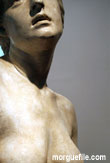
The use of scantily clad models in ads for everything from underwear to ice cream attests to the persuasive power of sex, but a surprising new study finds that our actions can be swayed by erotic images even when they don't consciously register in our awareness.
In an experiment, 40 men and women were shown erotic images that had been manipulated to bypass conscious detection. The participants consisted of both heterosexual and homosexual individuals.
Subjects were then shown a small "probe" pattern and asked to determine its orientation—clockwise or counterclockwise. The researchers found that subjects identified the probe pattern more accurately when it appeared where the erotic images had been, suggesting that the invisible images exerted an effect on their spatial attentions.
Pattern emerges
In general, the erotic images attracted or repelled attention depending on the gender of the nude model and also the sexual orientation of the subject. For example, heterosexual males tended to perform better on the pattern task when it followed the presentation of an invisible female nude than a male nude. Gay males, in contrast, showed more enhanced performance when exposed to invisible male nudes compared to female nudes.
"We didn't predict that," study team member Sheng He of the University of Minnesota told LiveScience. "We just wanted to see if invisible images can attract your attention or not."
For women, the results were more mixed. Heterosexual females performed better after exposure to invisible male nudes, but their performance didn't necessarily worsen when exposed to female nudes.
Sign up for the Live Science daily newsletter now
Get the world’s most fascinating discoveries delivered straight to your inbox.
The performances of homosexual and bisexual females were somewhere in-between heterosexual male and heterosexual female groups.
Subliminal messages
The researchers took advantage of a phenomenon called binocular rivalry to make the erotic images invisible. When two very different images are presented to each eye separately, the images will alternate between one image and the other. But if one eye is exposed to an image and the other to dynamic visual "noise," the noise will suppress the image and render it essentially invisible to the viewer.
Past studies have shown that the brain can process invisible information, but the new study shows it doesn't simply register the information, but also processes it in specific ways. A subliminal stimulus can attract or repel attention and thus influence our actions in different ways.
But don't worry, Sheng He said. There's little chance the techniques used in the team's experiment will find their way into advertising any time soon.
"You'd need to present two different images to the two eyes, and that's not easily achieved in everyday situations," he said.
The finding is detailed online in the Oct. 23 issue of the journal for the Proceedings of the National Academy of Sciences.
- A Brief History of Human Sex
- The Sex Quiz: Myths, Taboos and Bizarre Facts
- Erotic and Violent Images Cloud Vision, Study Finds
- Does Sex Really Sell? Perhaps Not to Women
- Most Popular Myths









